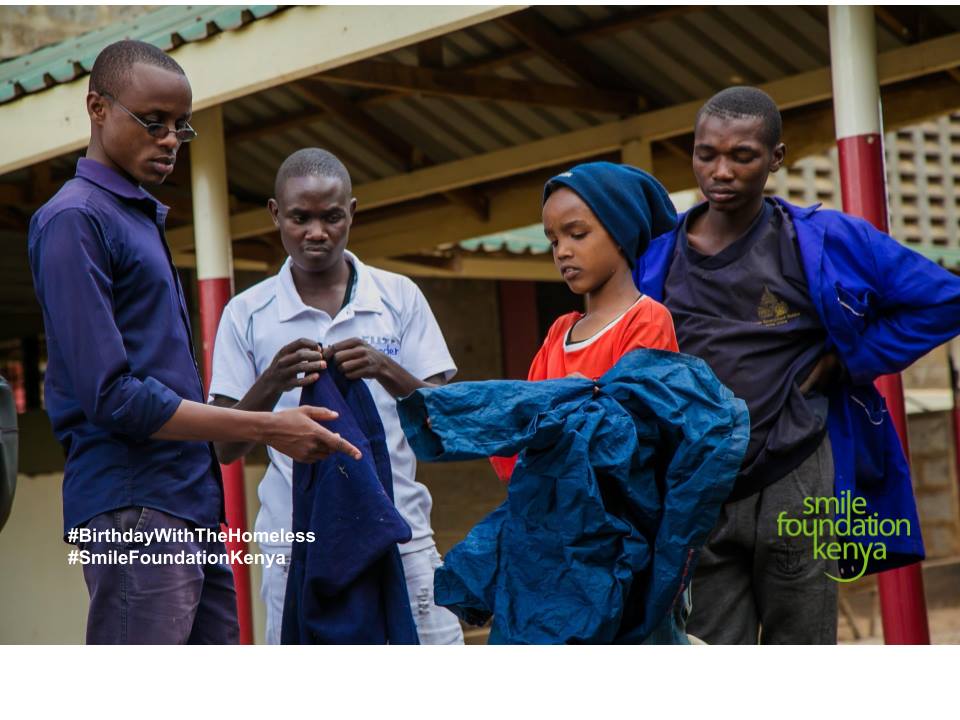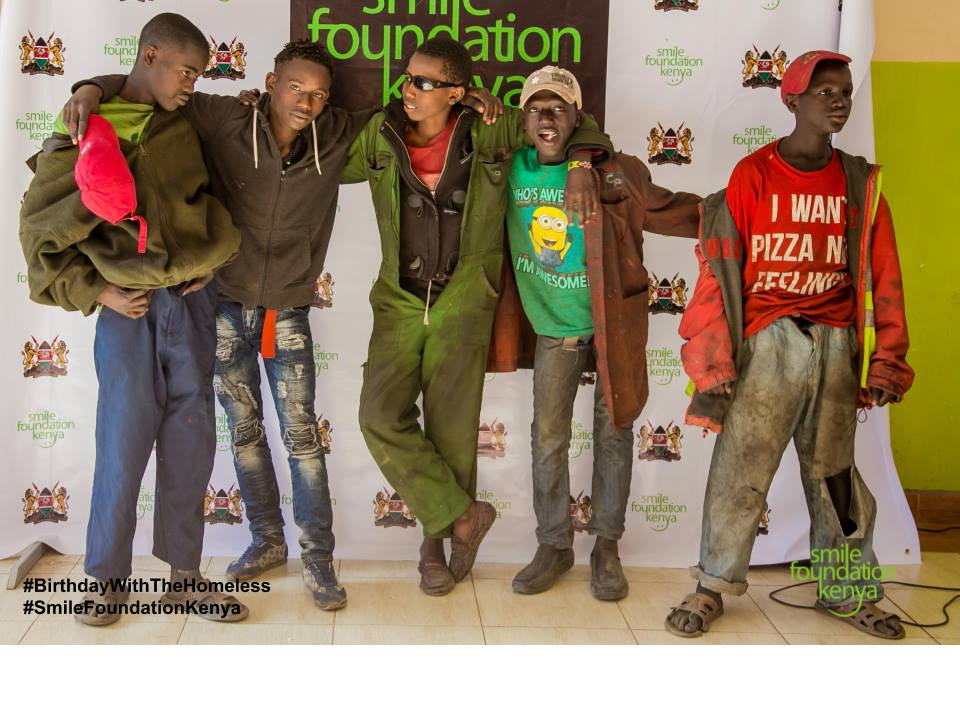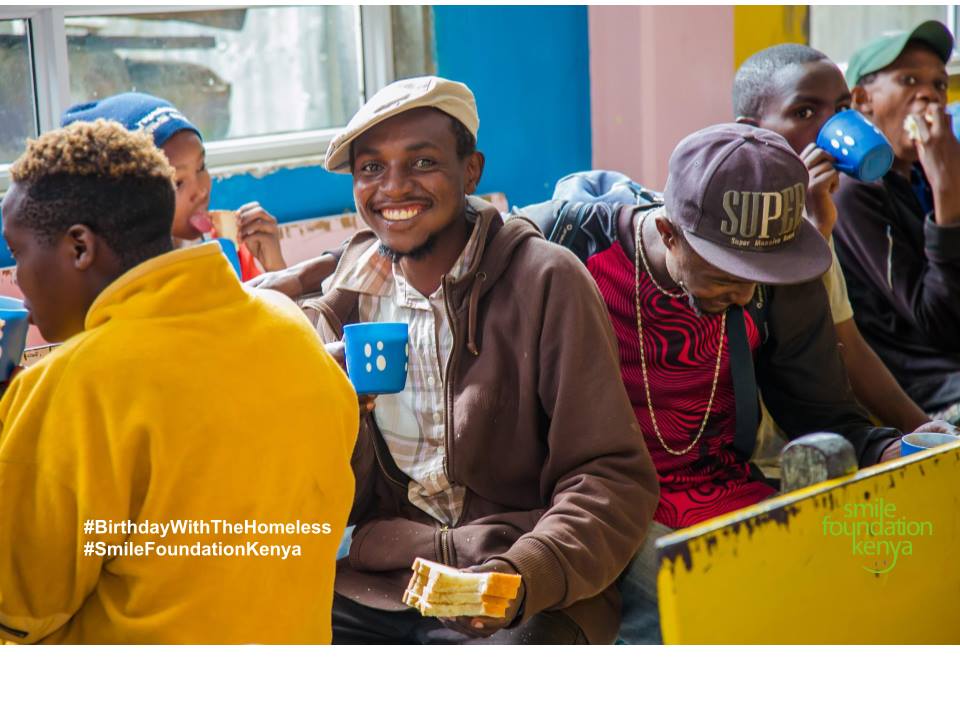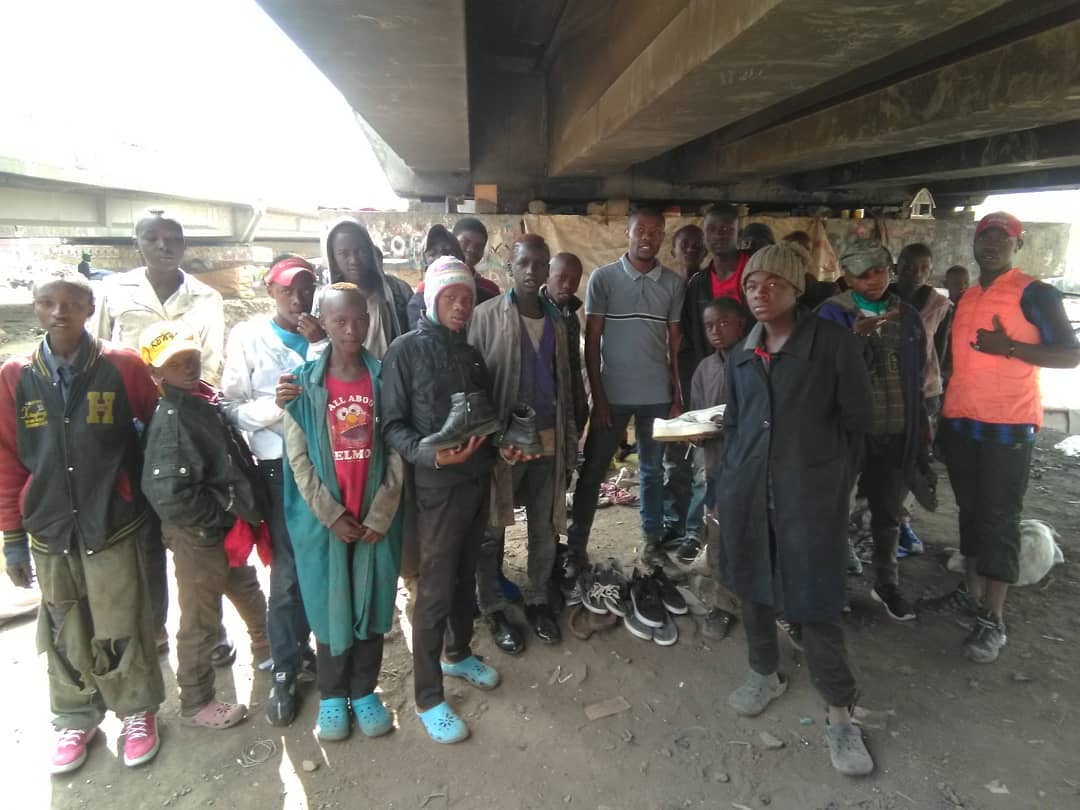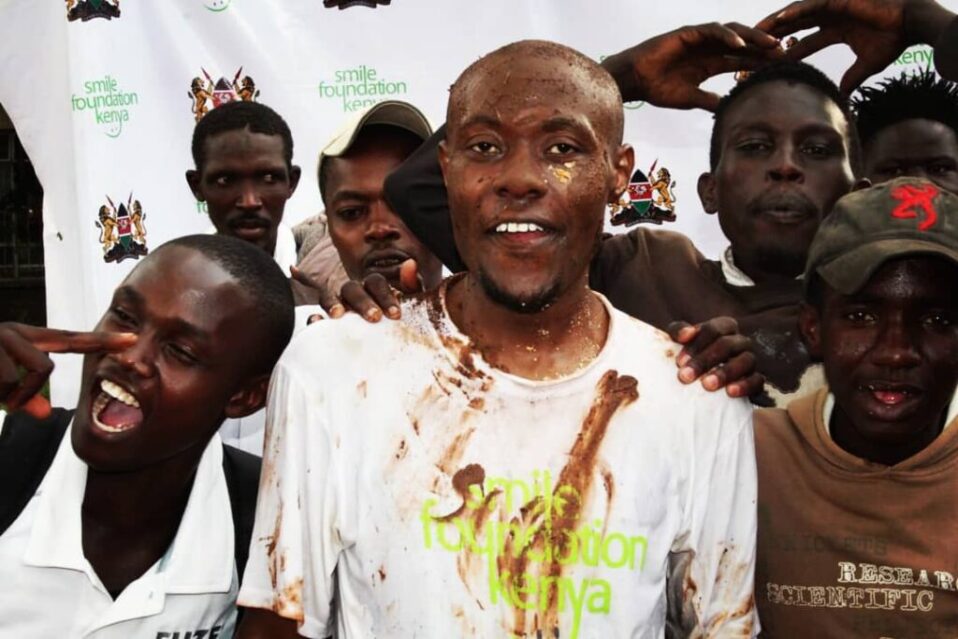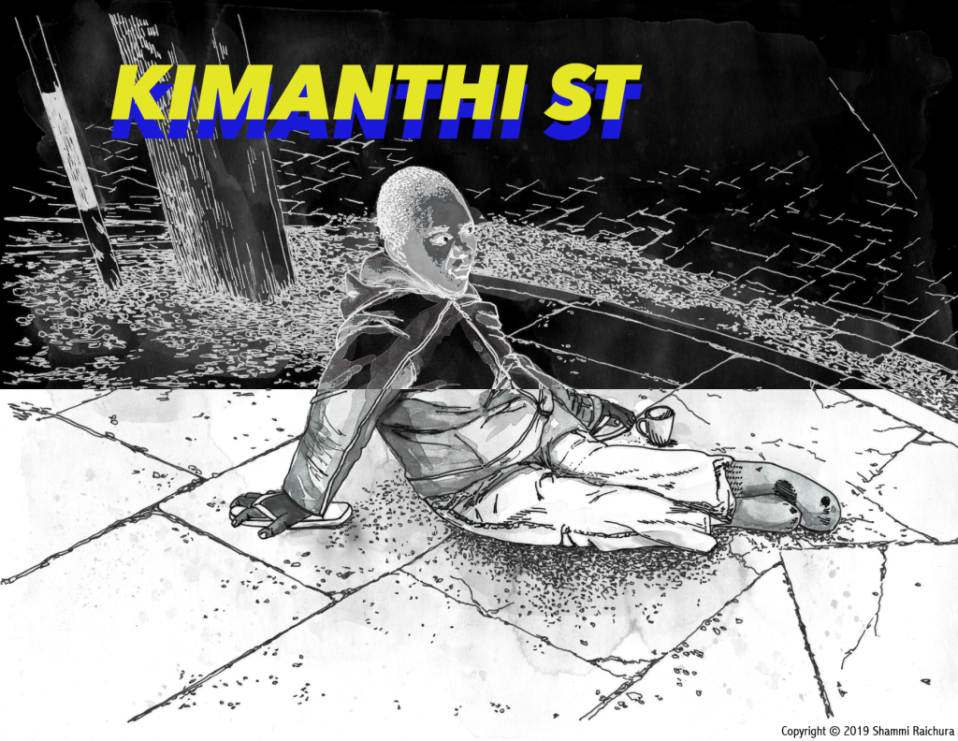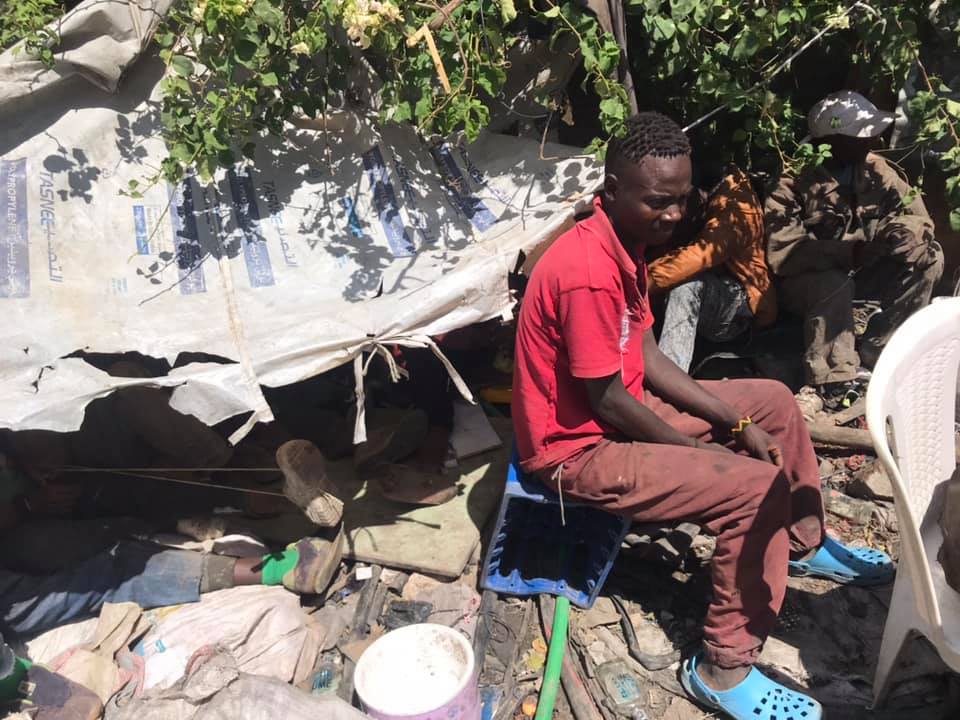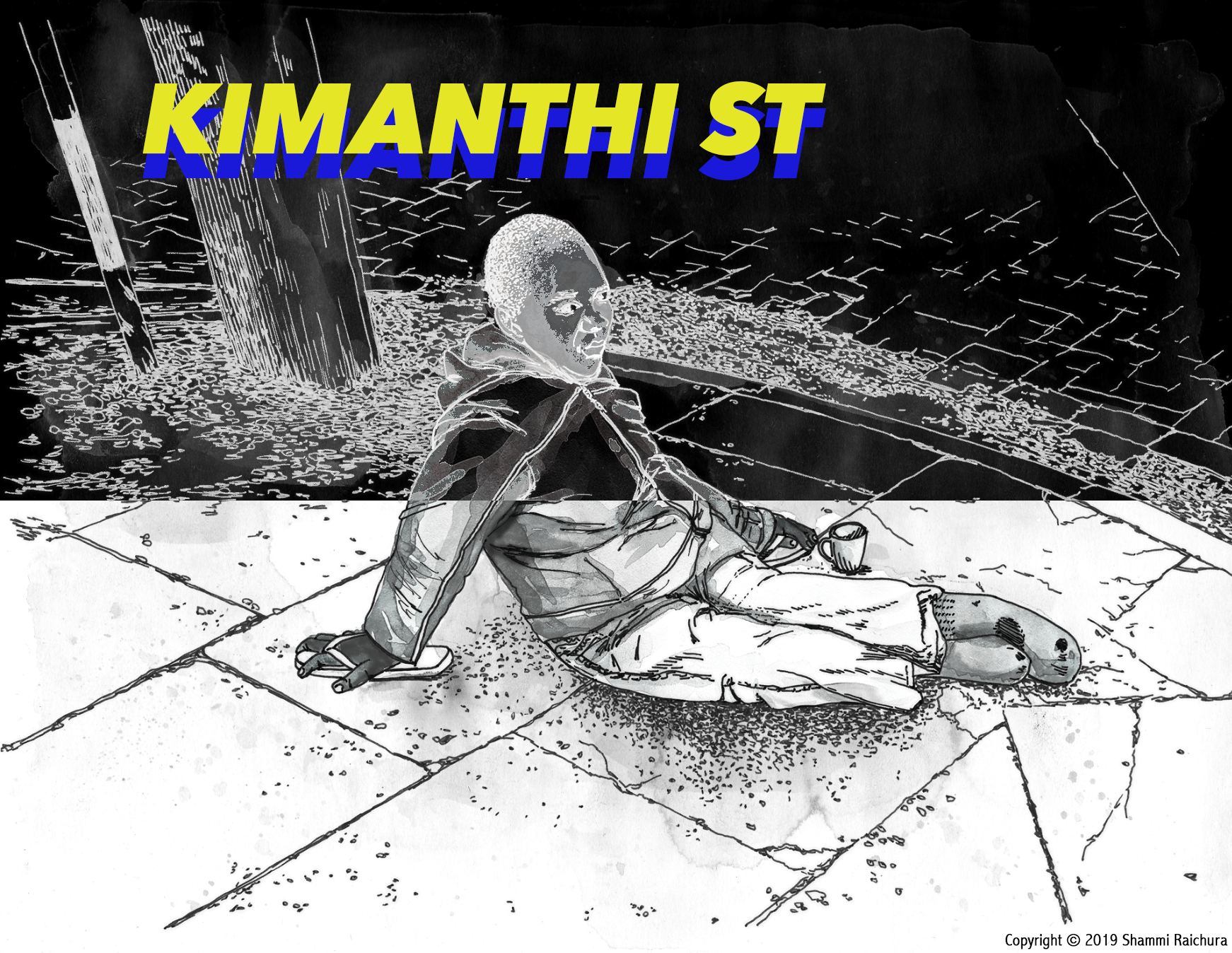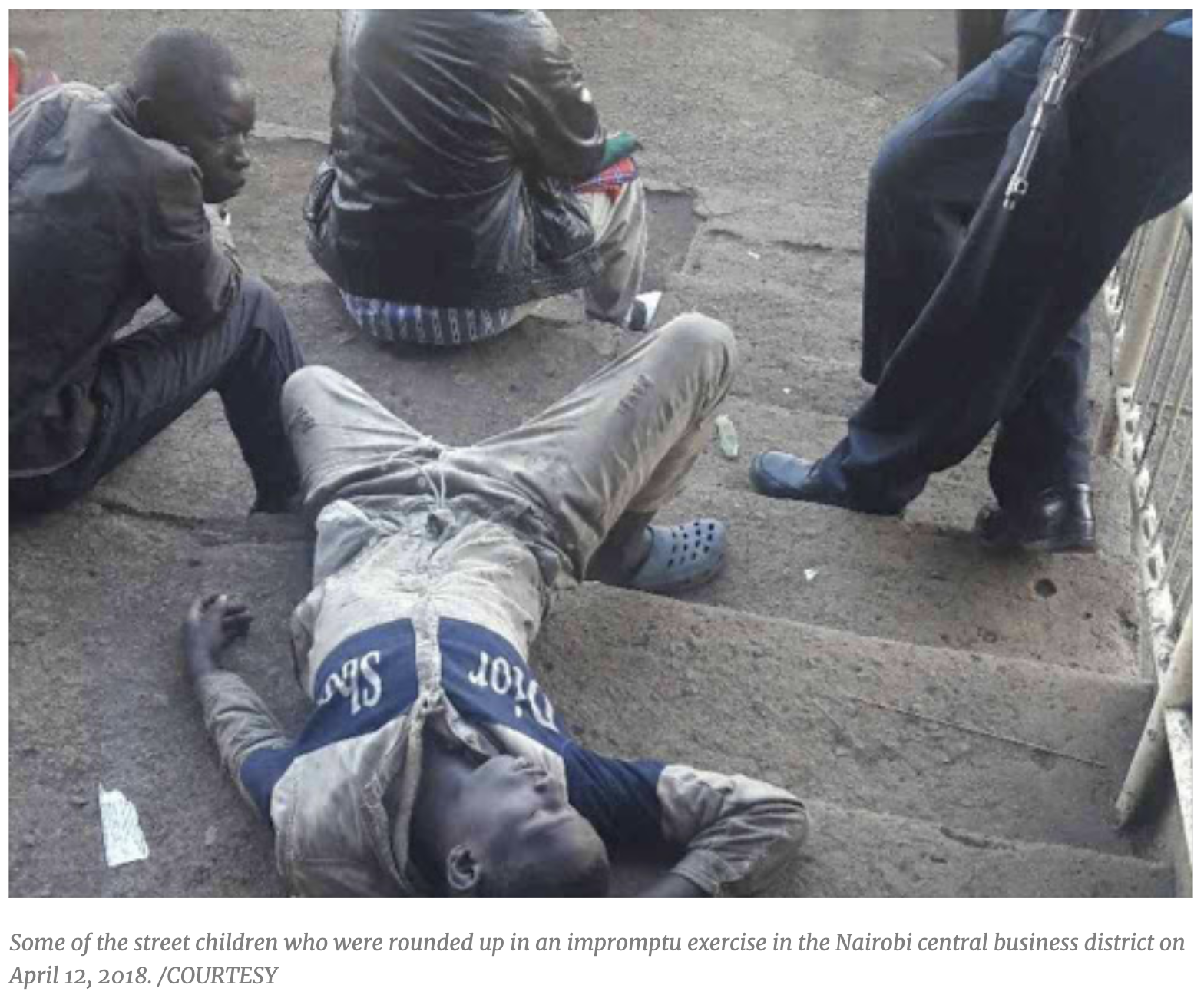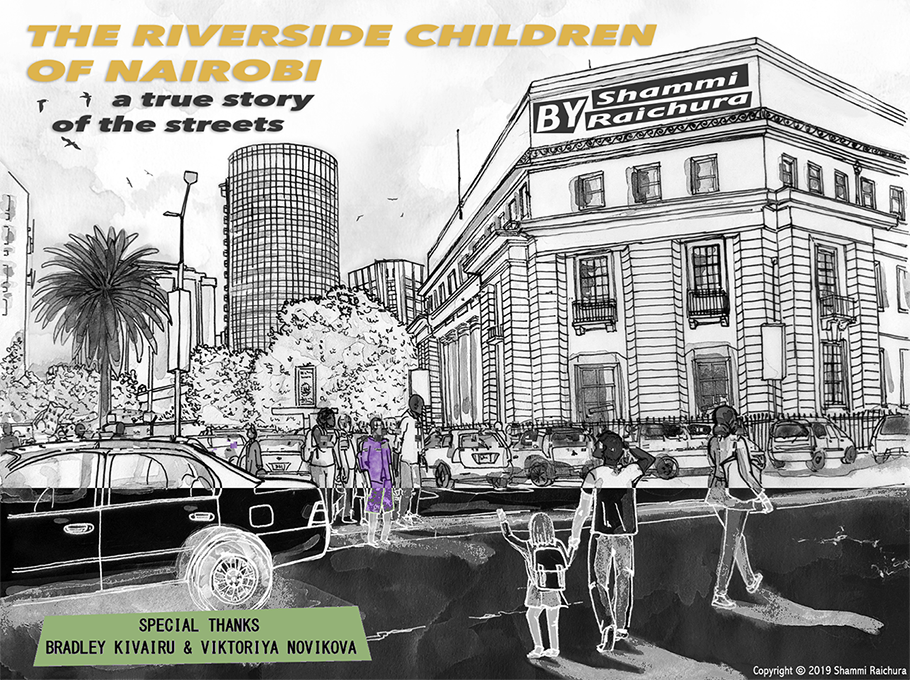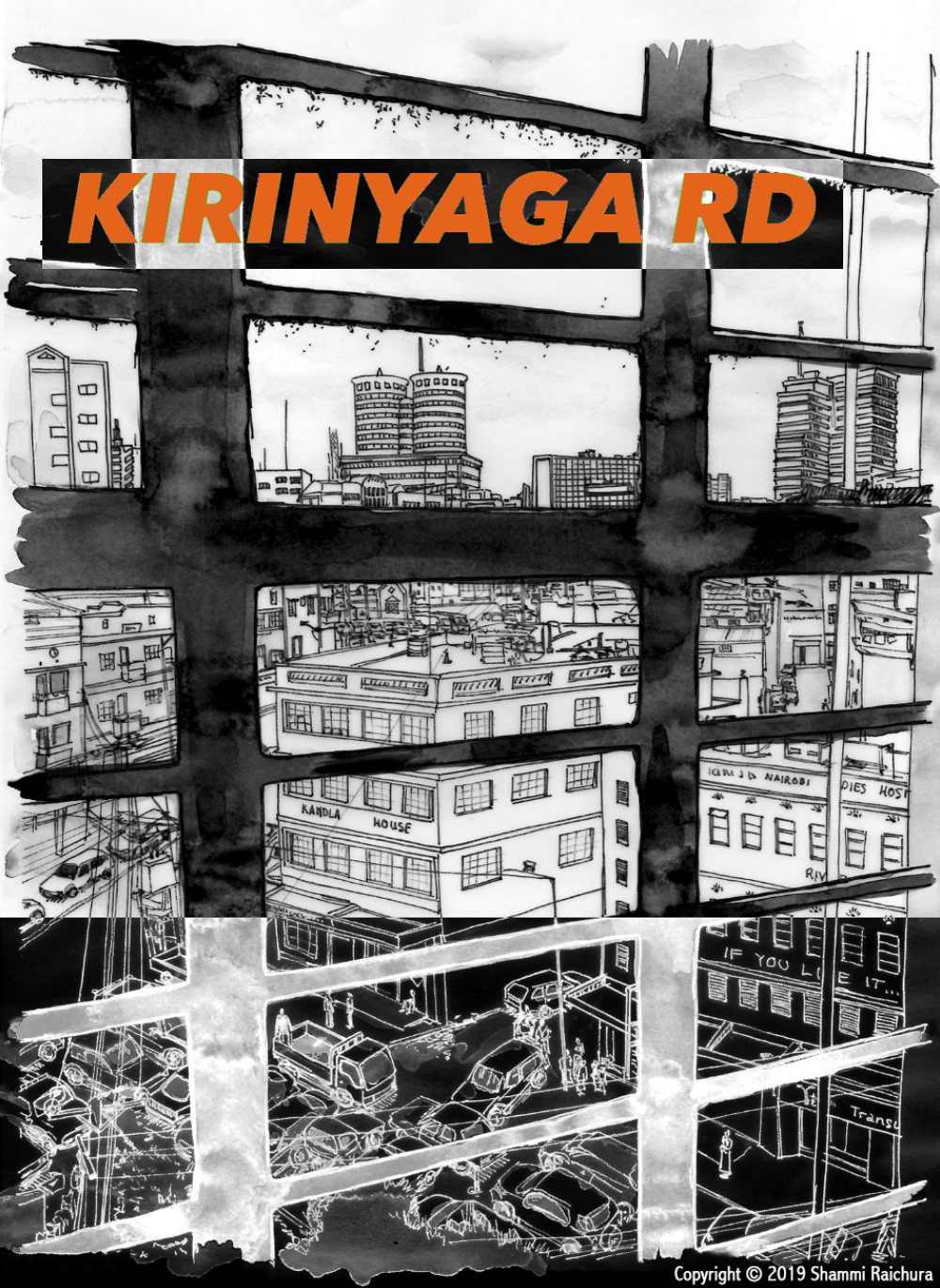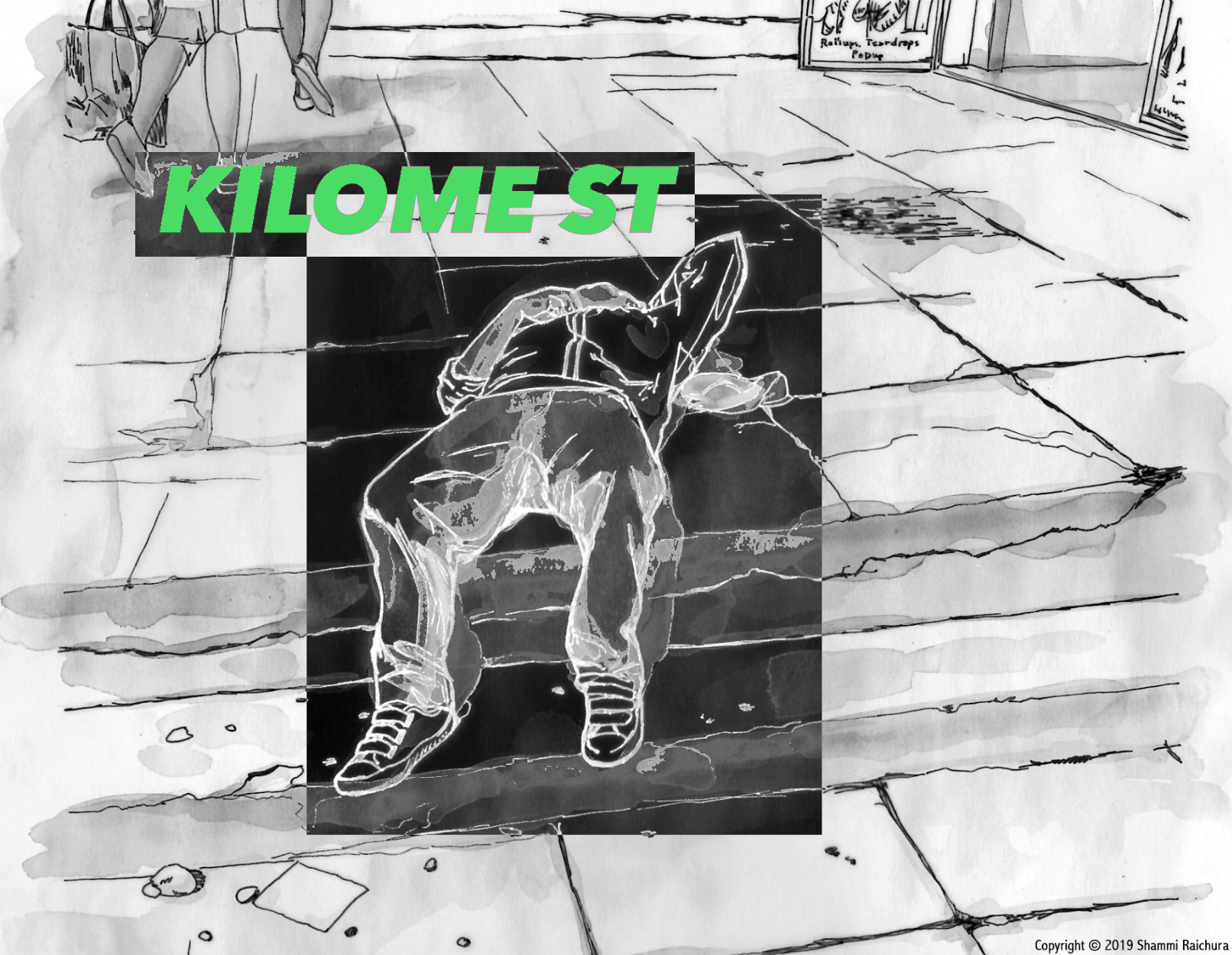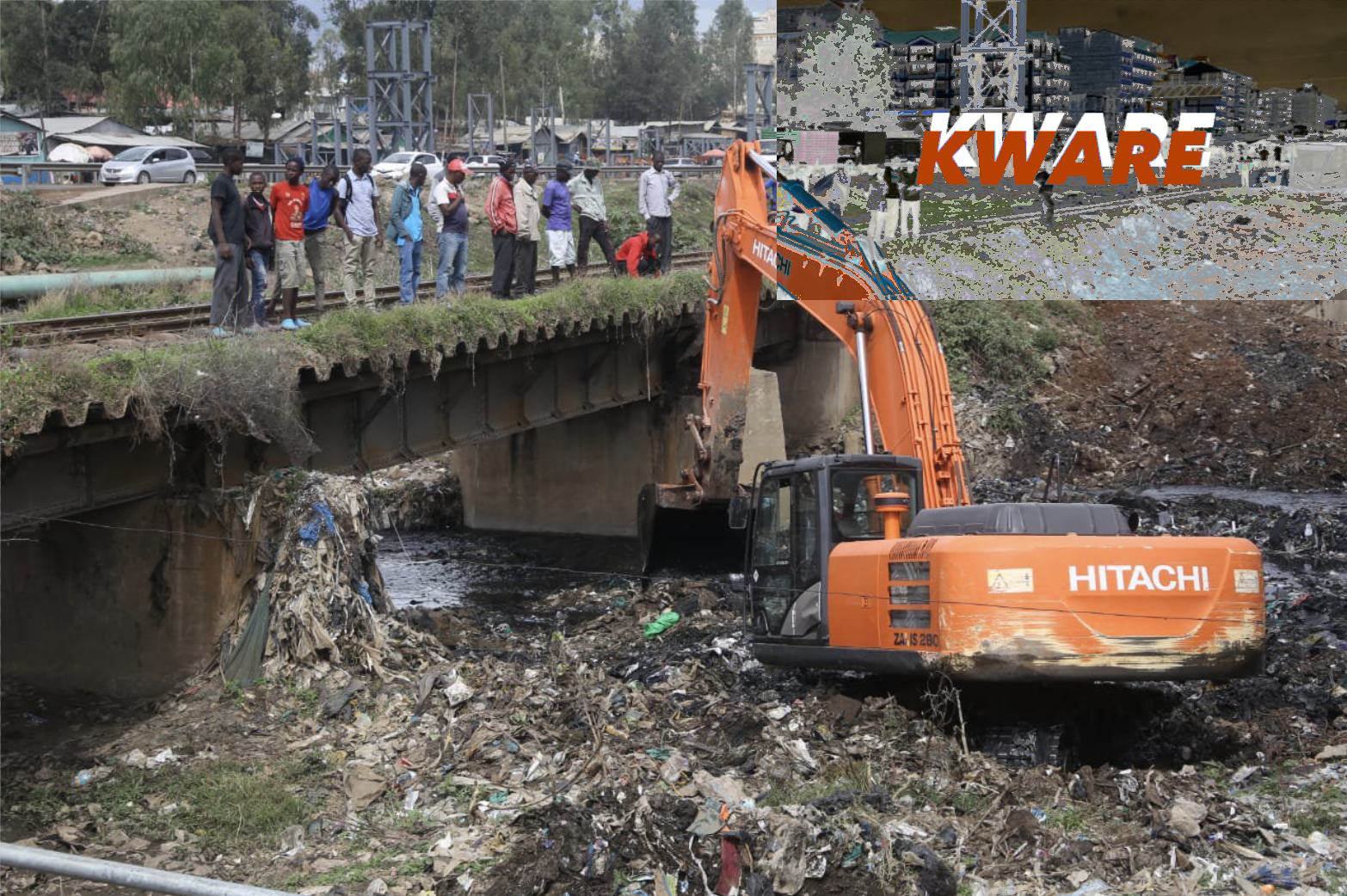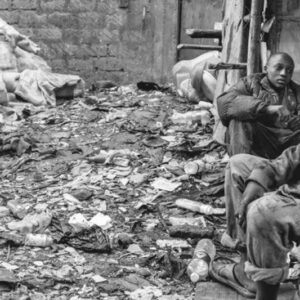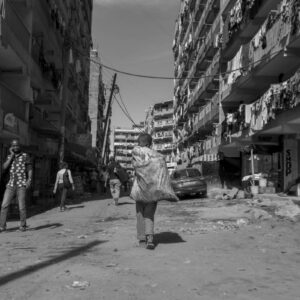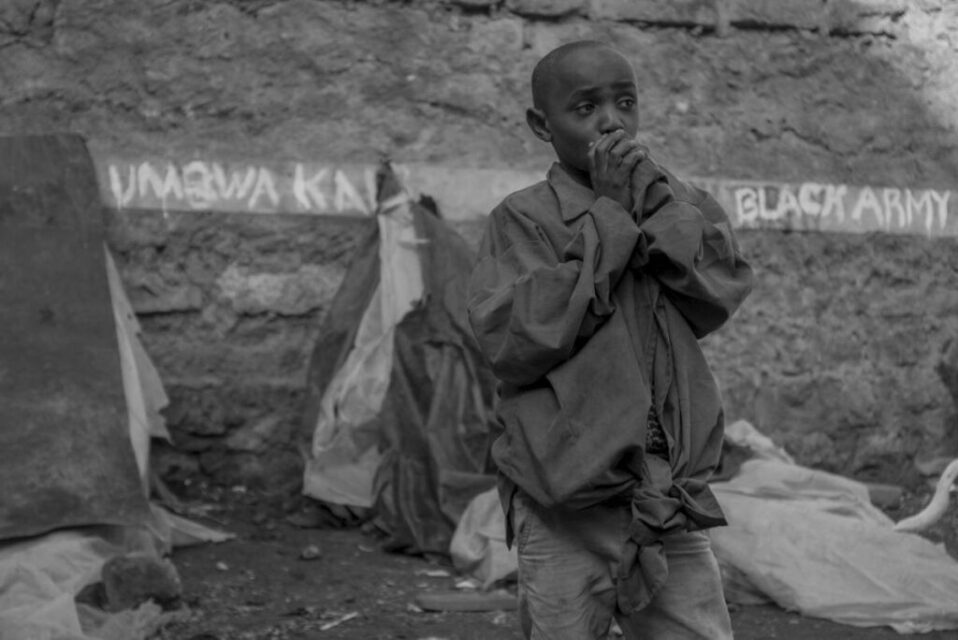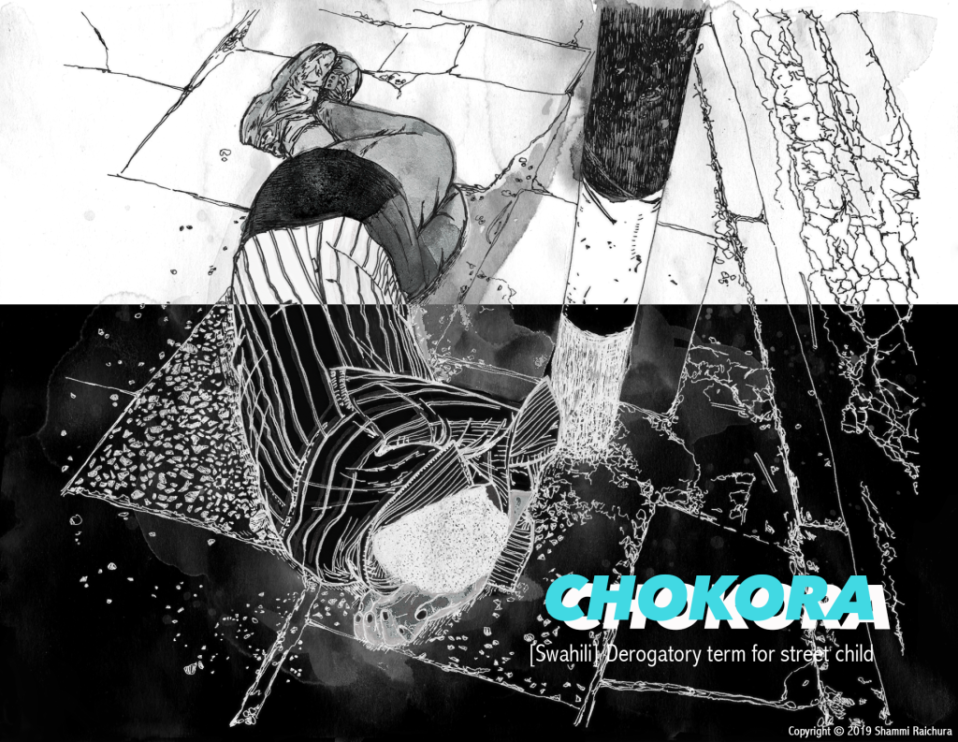Straatkinderen in Nairobi bezwijken onder een nieuwe rage: terpentine snuiven, de opvolger van lijmsnuiven. De bijnaam van msii, zoals de drugs in Kenia heet, is jet fuel, want je raakt er net zo high van als een vliegtuig. Koen de Regt bezocht de kinderen, die leven van vuilnis. ‘Terpentine geeft me de kracht om dit bestaan vol te houden.’
Alsof je keel dichtgeknepen wordt. Zo voelt het om een van de honderden plekken in Nairobi te bezoeken waar straatkinderen leven. Niet alleen de slechte omstandigheden waarin ze leven zijn aangrijpend, het is de geur van terpentine die meteen op je longen slaat als je bij de kinderen in de buurt komt.
We zijn in de wijk Donholm op bezoek bij de Black Army Gang. Een stoere naam, die heel wat lijkt voor te stellen en angst in zou moeten boezemen, maar eigenlijk is het een groepje van veertig verslaafde stakkers die zich elke dag samen door de dag heen worstelen. Het jongste lid is ongeveer 8 jaar oud, de oudste 18.
Ze leven op een braakliggend stuk grond tussen de flats, zo groot als een flinke tennisbaan. De grond is niet alleen bezaaid met afval, afval ís de grond. Wijkbewoners legen hier hun afvalemmers en de straatkinderen slepen hier zelf van alles naartoe. Aan de randen, tegen de muren van de andere gebouwen, zijn de slaapplekken: stukken zeil die met een stok omhoog worden gehouden. Totaal ongeschikte bescherming tegen de soms flinke regenbuien van Nairobi.
Dit is waar Simon van 14 jaar woont. En Trevor, 15 jaar oud. In een stad waar miljoenen mensen moeite hebben om het hoofd boven water te houden, zijn zij het laagste van het laagste. Ze leven van het afval, tussen het ongedierte, de straathonden en de stank. Om dat leven te kunnen verdragen, snuiven ze terpentine, dag in dag uit.
‘Het houdt me high,’ zegt Simon. ‘Het geeft me het gevoel dat ik niet alleen ben. Ook al heb ik allemaal jongens om me heen, toch voel ik me alleen. Maar hiermee niet. Het houdt me gezelschap.’ Trevor zegt dat hij zich op zijn gemak voelt als hij terpentine gebruikt. ‘Het geeft me de kracht om dit bestaan vol te houden.’
Master of ceremony
Ze noemen het msii, de terpentine. Waarom weet niemand, maar één theorie is dat het afgeleid is van MC, master of ceremony. Gebruikers van msii staan namelijk de hele dag met een onzichtbare microfoon voor hun mond. In hun hand hebben ze een doekje, dat gedrenkt is in terpentine. De giftige damp die daarvan afkomt, ademen ze in. Het effect dat het geeft, verdwijnt weer snel. Dus moet je het vaak inademen om high te blijven. Met een flesje van ongeveer 50 milliliter doen ze een middag. Het werkt snel. De bijnaam is niet voor niets jet fuel: je raakt net zo snel high als een vliegtuig.
Msii is niet duur. Voor ongeveer 80 eurocent kan een kind de hele dag high zijn. Dat zijn nog steeds grote bedragen als je zo weinig hebt als Simon en zijn vrienden, maar dat kunnen ze wel bij elkaar verdienen. Elke ochtend gaan de jongens op pad om het afval in de wijk te doorzoeken op spullen die ze kunnen doorverkopen voor recycling, zoals plastic en metalen. Het levert ze één, soms twee euro op. Genoeg om iets te eten en terpentine te kunnen kopen. Als ze een slechte dag hebben, wordt er geen eten gekocht en gaat alles op aan de msii. Ze eten dan wat ze tegenkomen op straat.
Vroeger snoven de straatkinderen in Nairobi lijm, maar dat is uit. De schoenmakerslijm is tegenwoordig moeilijker te krijgen, door ingrijpen van de overheid die lijmsnuiven wil uitbannen. Bovendien is een lijmsnuiver ook makkelijk te herkennen door het flesje met de gele substantie aan zijn mond. Een doekje met terpentine is veel makkelijker te verbergen voor de politie.
Maar de voornaamste reden voor de populariteit van msii is dat het een betere high zou geven. ‘Van lijm ga je trillen,’ zegt de 16-jarige David. ‘En het droop soms je mond in. Terpentine is niet zo zwaar voor je lichaam.’
Terpentinewalm
Onzin, natuurlijk. Ook terpentine is verwoestend voor je lijf. Volgens wetenschappers beschadigt het de hersenen, lever, longen en nieren. Maar je hoeft geen onderzoek te hebben gedaan om te weten dat wat deze kinderen doen, rampzalig is voor hun gezondheid. Kinderen die high zijn, lijken wel zombies. Ze schuifelen een beetje rond, kunnen nauwelijks praten en zijn compleet in zichzelf gekeerd. Ex-gebruikers klagen over maagzweren en een slecht geheugen. Ook al is het al jaren geleden dat ze voor het laatst terpentine hebben gesnoven. ‘Ik ben niet verslaafd. Ik kan stoppen wanneer ik wil,’ zegt Simon trots. Dat hij zichzelf voor de gek houdt, is duidelijk. Hij leeft immers al drie jaar op de basis in Donholm, en gebruikt al net zo lang. We zitten op een oude vrachtwagenband en proberen de andere jongens te negeren die rond ons zijn komen staan en ons met dode ogen aankijken. De terpentinewalm is haast niet te verdragen.
Simon is een slim joch, dat is al snel duidelijk. Als ik hem vraag om zijn achternaam te spellen, pakt ie mijn papier en pen en schrijft in keurige blokletters ‘Kimani’. Hij praat goed Engels. Een officiële taal in Kenia, maar straatjongens spreken het meestal niet. Hij draagt een trui van Nike die ooit rood was, en in zijn broek zitten grote gaten. Tot zijn elfde zat hij op school. ‘Ik was altijd nummer twee of drie van de klas. Mijn droom was om piloot te worden. Ik wil graag terug naar school om mijn droom werkelijkheid te laten worden. Maar dat kan nu niet meer, omdat ik hier zit.’
Hij kwam op straat door zijn stiefvader. Die sloeg hem, en accepteerde Simon niet als stiefzoon. ‘Hij betaalde ook niet voor school en gooide me het huis uit. Daar was ik erg boos over, maar ik kon er niks tegen doen.’ Zijn moeder greep niet in. ‘Ik had nergens om heen te gaan, dus kwam ik hier terecht. Deze groep is goed voor me geweest. Ze hebben me geholpen. Ik ben dankbaar dat ik nog leef.’
Het verhaal van Simon is exemplarisch, zegt Bradley Kivairu van de Smile Foundation Kenia. Hij probeert straatkinderen uit deze harde wereld te halen en terug naar school te krijgen. ‘De meeste van deze kinderen komen uit een gebroken gezin. Vaak is het zo dat de moeder in de steek is gelaten door de vader. De moeder moet met allerlei baantjes proberen het gezin te voeden. Daardoor is ze vaak weg. Er is dan tijd zat voor de kinderen om de straat op te gaan, waardoor ze gewend raken aan het straatleven.’ Ook Trevor is het slachtoffer van een vader die zijn verantwoordelijkheid niet nam. Twee jaar geleden ging zijn moeder dood. Omdat zijn vader allang vertrokken was, stond Trevor er alleen voor, om voor zijn jongere broer en zusje te zorgen. Die zitten inmiddels in een kindertehuis. Waarom hij daar ook niet zit, kan hij me niet duidelijk maken. Daarvoor is hij inmiddels veel te high. Hij knikkebolt, en zijn ogen staan op half zeven. ‘Ik zou ook wel veilig willen zijn, zoals mijn broer en zus,’ stamelt hij. ‘Ik vind het hier niet leuk. Ik haat het om altijd honger te hebben en om altijd maar vies te zijn. Mijn kleren zijn altijd vies.’
Groepsverkrachting
Het zijn voornamelijk jongens die in groepen zoals de Black Army Gang leven. Voor meisjes is het namelijk extra zwaar, door het seksuele geweld. Bradley Kivairu: ‘Om geaccepteerd te worden, wordt een meisje meestal eerst door de hele groep verkracht. Later wordt ze dan de vrouw van de leider.’
Margaret Wanjeri heeft twaalf jaar in een kamp voor straatkinderen gewoond. ‘Ik ken heel veel meisjes die zijn verkracht. Dat kwam door de drugs. Als meisjes het gebruiken, gaan ze zich uitdagender gedragen. Jongens, die ook high zijn, willen dan meteen seks. Ze voelen zich door de terpentine alsof ze de hele wereld aankunnen en denken dat ze alles kunnen doen wat ze willen.’
Inmiddels is Margaret 23 en probeert zoveel mogelijk weg te blijven uit het kamp. ‘Het is zo moeilijk om daar te leven, er gebeurt zoveel. De politie jaagt op ons, er zijn verkrachters. Je kunt niet rustig slapen.’
Sinds een week probeert Margaret te stoppen met de msii. Als we haar spreken is ze inderdaad ook helder. Ze heeft zelfs een beetje blauwe oogschaduw op, waardoor ze er ‘normaal’ uitziet. Maar het stoppen valt haar zwaar. ‘Het is heel moeilijk. Ik probeer het, maar ben er nog niet helemaal vanaf. Het zit in je lijf, in je bloed. Ik voel me ziek als ik het niet gebruik. Maar ik wil ermee stoppen, vanwege mijn kinderen.’ Margaret is namelijk moeder; in haar tijd op straat kreeg ze drie kinderen. De jongste is bijna 3 jaar oud.
Harde aanpak
Hoeveel kinderen op straat leven is onbekend, maar experts gaan uit van vele duizenden. Er zijn ook tientallen hulporganisaties, maar zelfs samen kunnen zij niet alle kinderen van de straat halen. ‘Wij helpen er elk jaar tachtig tot honderd,’ zegt pater Benn Agung. Hij werkt voor de Don Bosco Boys, een katholieke organisatie. ‘Dat is een flink aantal, want we zijn helemaal afhankelijk van donoren. We moeten ze kleden, opleiden en voor ze zorgen. Het is een druppel op een gloeiende plaat, maar het is zeker iets.’
Maar geld is ook niet de belangrijkste reden waarom niet elk straatkind geholpen kan worden. Ze laten zich ook heel moeilijk helpen. Ze zomaar van straat trekken en in een afkickkliniek zetten, werkt niet. ‘Ons programma is op vrijwillige basis,’ zegt Agung. ‘We dwingen ze niet, want dan gaan ze na een dag weer terug de straat op. We hebben dat inmiddels al zo vaak meegemaakt: ze zijn verslaafd, aan hun vrijheid gewend en buitengewoon wantrouwend tegen alles wat die vrijheid weg zou kunnen nemen.’
Ook Kivairu van de Smile Foundation heeft die ervaring. ‘We hebben het geprobeerd, geloof me. We hebben zelfs huizen gehuurd voor ze. Dat gaat verkeerd, omdat er voor je het weet drugs worden gebruikt, en het huis een puinhoop wordt. Tot de buurt het beu is, en ze er uit jaagt.’ De Keniaanse overheid kiest nu voor een harde aanpak. De kinderen worden regelmatig opgepakt of van hun vaste plek weggestuurd. Ook is het verboden om spullen op straat te verkopen zonder vergunning. Kinderen die dat toch proberen, zijn doelwit van agenten. Helemaal verkeerd, vindt Agung van Don Bosco. ‘Het is een kortetermijnaanpak. De overheid heeft gefaald om het belangrijkste probleem aan te pakken: het gebrek aan banen. De kinderen van straat sturen, of ze verbannen naar buitenwijken, helpt misschien om ze te verbergen voor bezoekers van Nairobi, maar het probleem is er nog steeds.’
De enige methode, daar zijn Kivairu en Agung het over eens, is stapje voor stapje contact leggen met de kinderen. Erheen gaan, ze te eten geven en zo langzaam een band opbouwen. Pas als die er is, kan er gesproken worden over deelname aan een af kickprogramma. Toch is zelfs dat niet altijd genoeg, zegt Agung. ‘Van onze oud-studenten zijn inmiddels vijftig jongens dood. Want ze hebben dan wel een opleiding bij ons gehad, maar als dat klaar is hebben ze nog geen baan. Vaak gaan ze dan alsnog de criminaliteit in, en worden dan neergeschoten door bewakers of burgers die het recht in eigen hand nemen.’
Gelukkig gaat het vaak genoeg ook goed. Gideon Mungai (23) is door de Smile Foundation van straat gehaald. ‘Het is een wonder dat ik hier nog zit,’ zegt hij. ‘Zij en de kerk kwamen naar ons kamp, en bleven komen. Vrienden van me zijn opgepakt of vermoord, maar ik leef nog.’
Zwerende wond
In het kamp van de Black Army Gang wordt inmiddels ‘gekookt’. Een van de jongens heeft een zak slachtafval gevonden, en dat wordt in een potje op het houtvuur klaargemaakt. De tientallen straathonden kijken toe, hopend op een restje van de restjes. De jongens en de honden hebben een diepe band. Het is alsof ze weten dat ze het met elkaar zullen moeten rooien.
‘Deze heet Big Ears.’ Simon wijst naar de hond die aan zijn voeten ligt, met een flinke zwerende wond op de rug. ‘Ik hou van die hond. Waar ik ook ga, zij gaat altijd met me mee. Ze is mijn beste vriend.’ Hij geeft haar een aai, zet het doekje met terpentine aan zijn mond en ademt in.
